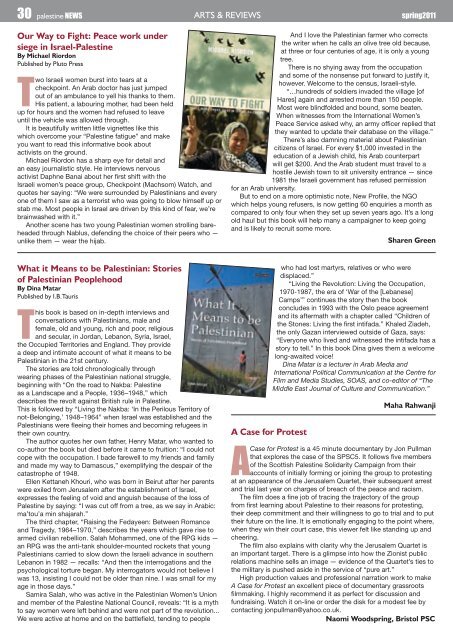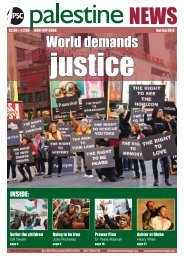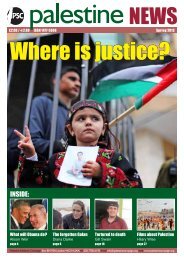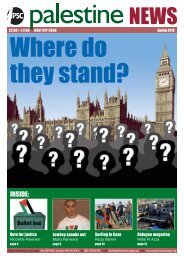InsIDe: - Palestine Solidarity Campaign
InsIDe: - Palestine Solidarity Campaign
InsIDe: - Palestine Solidarity Campaign
You also want an ePaper? Increase the reach of your titles
YUMPU automatically turns print PDFs into web optimized ePapers that Google loves.
30 palestine news ARTS & REVIEWSspring2011Our Way to Fight: Peace work undersiege in Israel-<strong>Palestine</strong>By Michael RiordonPublished by Pluto PressTwo Israeli women burst into tears at acheckpoint. An Arab doctor has just jumpedout of an ambulance to yell his thanks to them.His patient, a labouring mother, had been heldup for hours and the women had refused to leaveuntil the vehicle was allowed through.It is beautifully written little vignettes like thiswhich overcome your “<strong>Palestine</strong> fatigue” and makeyou want to read this informative book aboutactivists on the ground.Michael Riordon has a sharp eye for detail andan easy journalistic style. He interviews nervousactivist Daphne Banai about her first shift with theIsraeli women’s peace group, Checkpoint (Machsom) Watch, andquotes her saying: “We were surrounded by Palestinians and everyone of them I saw as a terrorist who was going to blow himself up orstab me. Most people in Israel are driven by this kind of fear, we’rebrainwashed with it.”Another scene has two young Palestinian women strolling bareheadedthrough Nablus, defending the choice of their peers who —unlike them — wear the hijab.And I love the Palestinian farmer who correctsthe writer when he calls an olive tree old because,at three or four centuries of age, it is only a youngtree.There is no shying away from the occupationand some of the nonsense put forward to justify it,however. Welcome to the census, Israeli-style.“…hundreds of soldiers invaded the village [ofHares] again and arrested more than 150 people.Most were blindfolded and bound, some beaten.When witnesses from the International Women’sPeace Service asked why, an army officer replied thatthey wanted to update their database on the village.”There’s also damning material about Palestiniancitizens of Israel. For every $1,000 invested in theeducation of a Jewish child, his Arab counterpartwill get $200. And the Arab student must travel to ahostile Jewish town to sit university entrance — since1981 the Israeli government has refused permissionfor an Arab university.But to end on a more optimistic note, New Profile, the NGOwhich helps young refusers, is now getting 60 enquiries a month ascompared to only four when they set up seven years ago. It’s a longold haul but this book will help many a campaigner to keep goingand is likely to recruit some more.Sharen GreenWhat it Means to be Palestinian: Storiesof Palestinian PeoplehoodBy Dina MatarPublished by I.B.TaurisThis book is based on in-depth interviews andconversations with Palestinians, male andfemale, old and young, rich and poor, religiousand secular, in Jordan, Lebanon, Syria, Israel,the Occupied Territories and England. They providea deep and intimate account of what it means to bePalestinian in the 21st century.The stories are told chronologically throughwearing phases of the Palestinian national struggle,beginning with “On the road to Nakba: <strong>Palestine</strong>as a Landscape and a People, 1936–1948,” whichdescribes the revolt against British rule in <strong>Palestine</strong>.This is followed by “Living the Nakba: ‘In the Perilous Territory ofnot-Belonging,’ 1948–1964” when Israel was established and thePalestinians were fleeing their homes and becoming refugees intheir own country.The author quotes her own father, Henry Matar, who wanted toco-author the book but died before it came to fruition: “I could notcope with the occupation. I bade farewell to my friends and familyand made my way to Damascus,” exemplifying the despair of thecatastrophe of 1948.Ellen Kettaneh Khouri, who was born in Beirut after her parentswere exiled from Jerusalem after the establishment of Israel,expresses the feeling of void and anguish because of the loss of<strong>Palestine</strong> by saying: “I was cut off from a tree, as we say in Arabic:ma’tou’a min shajarah.”The third chapter, “Raising the Fedayeen: Between Romanceand Tragedy, 1964–1970,” describes the years which gave rise toarmed civilian rebellion. Salah Mohammed, one of the RPG kids —an RPG was the anti-tank shoulder-mounted rockets that youngPalestinians carried to slow down the Israeli advance in southernLebanon in 1982 — recalls: “And then the interrogations and thepsychological torture began. My interrogators would not believe Iwas 13, insisting I could not be older than nine. I was small for myage in those days.”Samira Salah, who was active in the Palestinian Women’s Unionand member of the <strong>Palestine</strong> National Council, reveals: “It is a mythto say women were left behind and were not part of the revolution...We were active at home and on the battlefield, tending to peopleA Case for Protestwho had lost martyrs, relatives or who weredisplaced.”“Living the Revolution: Living the Occupation,1970-1987, the era of ‘War of the [Lebanese]Camps’” continues the story then the bookconcludes in 1993 with the Oslo peace agreementand its aftermath with a chapter called “Children ofthe Stones: Living the first intifada.” Khaled Ziadeh,the only Gazan interviewed outside of Gaza, says:“Everyone who lived and witnessed the intifada has astory to tell.” In this book Dina gives them a welcomelong-awaited voice!Dina Matar is a lecturer in Arab Media andInternational Political Communication at the Centre forFilm and Media Studies, SOAS, and co-editor of “TheMiddle East Journal of Culture and Communication.”Maha RahwanjiACase for Protest is a 45 minute documentary by Jon Pullmanthat explores the case of the SPSC5. It follows five membersof the Scottish <strong>Palestine</strong> <strong>Solidarity</strong> <strong>Campaign</strong> from theiraccounts of initially forming or joining the group to protestingat an appearance of the Jerusalem Quartet, their subsequent arrestand trial last year on charges of breach of the peace and racism.The film does a fine job of tracing the trajectory of the groupfrom first learning about <strong>Palestine</strong> to their reasons for protesting,their deep commitment and their willingness to go to trial and to puttheir future on the line. It is emotionally engaging to the point where,when they win their court case, this viewer felt like standing up andcheering.The film also explains with clarity why the Jerusalem Quartet isan important target. There is a glimpse into how the Zionist publicrelations machine sells an image — evidence of the Quartet’s ties tothe military is pushed aside in the service of “pure art.”High production values and professional narration work to makeA Case for Protest an excellent piece of documentary grassrootsfilmmaking. I highly recommend it as perfect for discussion andfundraising. Watch it on-line or order the disk for a modest fee bycontacting jonpullman@yahoo.co.uk.Naomi Woodspring, Bristol PSC







